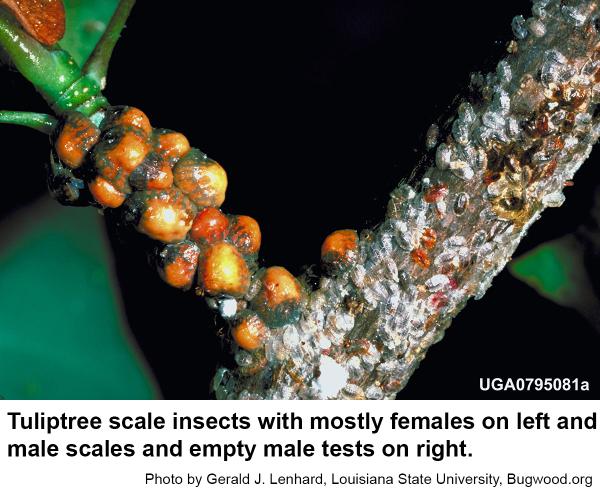Description and Biology
Tuliptree scale, Toumeyella liriodendri, is one of our largest scale insects and is sometimes quite damaging to tuliptree and magnolia. This soft scale sometimes covers twigs and branches making the bark look warty. Female scales grow to ¼ inch and are oval, humped, and have a distinct flange except when they are so abundant that there is no room for the flange to develop. Mature females are pinkish orange with black splotches. It has one generation per year. The biology is unusual in that the scales reproduce in late summer and the tiny new scales overwinter on the twigs and stems. (Most other soft scale insect pests of ornamentals reproduce in May or early June.) Male tuliptree scales appear in early summer and mate with the females. The females swell considerably with eggs during the summer (up to 3,000!). The eggs hatch as they are laid so that it appears the crawlers are born rather than hatched. The crawlers are dark red. They settle on new stems and molt into overwintering nymphs. Crawlers also spread to new hosts by wind or by hitching rides on birds.
Host Plants
Tuliptree scales infest magnolias and tuliptree. Infested trees often become sticky with honeydew excreted by the scales and black with sooty mold fungi that grow in the honeydew. Heavily infested trees may be weakened with sparse foliage and dead branches. The trunks may be distorted because the scales have killed out the leader branches over the years. Most homeowners object to the honeydew and the wasps, flies and bees that are attracted to the honeydew.
Residential Recommendations
This scale is pestered by numerous parasitic and predaceous insects (including woolly lady beetle larvae and a predaceous caterpillar!). Sometimes these natural controls are unable to keep up with the scales. In that case, infested plants small enough to treat can be sprayed. Most insecticides labeled for landscape use should give more than adequate control especially if directed at the very young scales in the fall. Wait for the leaves to fall for better coverage. Using a horticultural oil either as an adjuvant for better penetration of another pesticide or using oil as the primary insecticide will help kill sooty mold fungi as well.
References
- Soft Scale Identification and Management on Ornamental Plants. Frank, S. 2010. Entomology Insect Notes, NC State Extension Publications.
- Sooty Molds. Frank, S. D., S. B. Bambara and R. K. Jones. 2002 revised. Entomology Insect Notes, NC State Extension Publications
- Tuliptree Scale, Toumeyella liriodendri (Gmelin). Hoover, Sr. G. A. 2016. Insect Advice from Extension. PennState College of Agricultural Sciences Department of Entomology.
- Extension Plant Pathology Publications and Factsheets
- Horticultural Science Publications
- North Carolina Agricultural Chemicals Manual
For assistance with a specific problem, contact your local Cooperative Extension Center.
This Factsheet has not been peer reviewed.
Publication date: May 4, 2016
Reviewed/Revised: Oct. 17, 2019
Recommendations for the use of agricultural chemicals are included in this publication as a convenience to the reader. The use of brand names and any mention or listing of commercial products or services in this publication does not imply endorsement by NC State University or N.C. A&T State University nor discrimination against similar products or services not mentioned. Individuals who use agricultural chemicals are responsible for ensuring that the intended use complies with current regulations and conforms to the product label. Be sure to obtain current information about usage regulations and examine a current product label before applying any chemical. For assistance, contact your local N.C. Cooperative Extension county center.
N.C. Cooperative Extension prohibits discrimination and harassment regardless of age, color, disability, family and marital status, gender identity, national origin, political beliefs, race, religion, sex (including pregnancy), sexual orientation and veteran status.


